If you want to know the time ask a policeman. That may not be such
a bad idea these days, especially if his little radio is capable
of picking up the time code from Rugby. The ever punctual Rick Maybury
looks at atoms that tick phones that tock and watches that don't
make any noise at all.
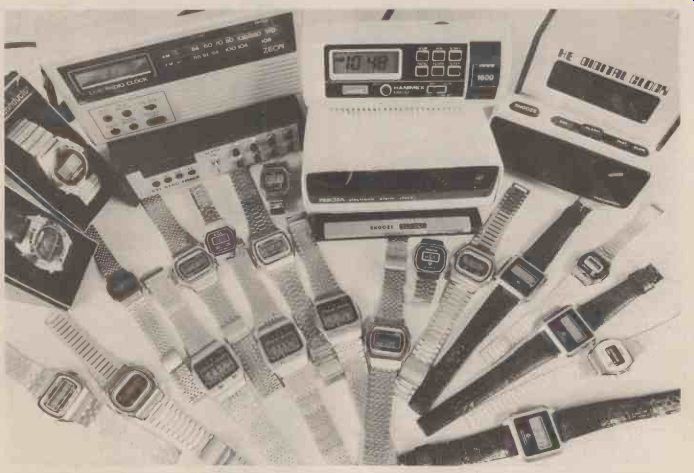
------- Electronic Timekeeping, Hobby Electronics style, these
are just some of the examples of electronic timekeeping available
from our Marketplace special offers. The HE Digital Clock was featured
as a project in our very first issue in November '78.
IT HAS ALWAYS BEEN EASY to tell the time, even if you haven't got a clock or watch you could probably guess to within half an hour. Even before the development of reliable mechanical timepieces, the sundial, sand clock, water clock or even a slow burning candle could indicate the time to the nearest minute. Probably the single most important invention in timekeeping was the pendulum in 1582, it enabled time to be measured to the second.
After that things remained fairly static for the next couple of hundred years. Mechanical escapements improved over the years to such a degree that fractions of a second, as little as 100th of a second, could be accurately measured. Very little new technology came into the field of timekeeping until along came our old friend electricity, then it all began to happen.
TIME ON TAP
At first electricity just replaced mechanical energy in electric clocks, until some b5ight spark in 1918 discovered that an AC electric motor could be synchronized (synchronous motor) to the frequency of the mains. It didn't take long for the electricity board to latch on to this and ensure that over a 24-hour period their generators maintained an average frequency. A clock locked to mains frequency could be compared with a known standard and any losses or gains by the mains-linked clock could be compensated for by slowing down or speeding up the generators. This system of using a central oscillator was the forerunner of today's central standard clock operated by the National Physical Laboratory.

---- Divider chain for decoding the mains 50 Hz into a 1 Hz
output, the 1 Hz is then used to drive a further chain (see page
54) which will generate the various hours, minutes, seconds and
calendar outputs.
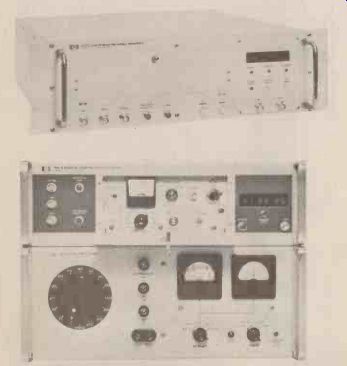
-------- Atomic clocks. The upper one is a laboratory standard
Cesium Beam Frequency Reference, a time output is displayed on the
right. The lower one is a portable version of the Cesium Beam clock
intended for experimental use, the freedom from mains electricity
enables the clock to operate safely even during power cuts.
ATOMIC TICK TOCK
The NPL clock and all standard clocks around the world are based on Atomic Time (AT). There are two main methods of deriving atomic time, they are both based on the natural vibrations of certain materials. These vibrations or Atomic Resonance happens to be one of natures invariables, rather like the speed of light, it is a fixed constant.
The oldest and most accurate type of atomic clock is the Cesium Atomic Beam Controlled Oscillator, quite a mouthful for a really quite simple device. (No we won't be featuring one as a project in HE, it's not that simple).
The 'clock' is based upon a quartz oscillator, usually running at 5 MHz. This is multiplied up, to the resonant frequency of Cesium. This is a good point to do a bit of defining:
A second is defined as: The duration of 9,192,631,771 periods of transition within the Cesium atom.
So to put it crudely the 5 MHz is bumped up to around 9192 MHz and fed to a microwave cavity full of Cesium vapor. The Cesium will of course resonate at only that frequency. Any disparity between the quartz oscillator and the resonating Cesium will generate a difference signal that can be 'fedback' to the crystal oscillator. A frequency lock circuit keeps the crystal oscillator running at the same frequency as the vibrating cesium atoms. In practice the output from this now very stable oscillator is divided down to a usable frequency, usually 1 MHz and 100 kHz so further manipulation will provide an output suitable for timekeeping.
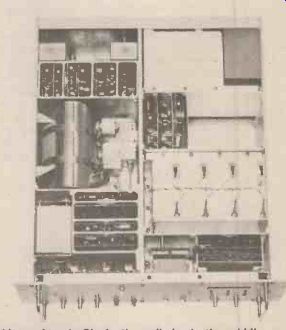
------- Inside an Atomic Clock, the cylinder in the middle,
on the left-hand side is the actual gas cell, the control circuitry
and quartz oscillators can be seen at the top, again on the left.
The second main type of Atomic clock is the Rubidium Gas Cell Controlled Oscillator. To cut a very long story short, the Rubidium clock operates in a very similar manner to the Cesium clock. Suffice it to say that it is not quite as accurate in the long term as the Cesium clock, variables like the pressure of the Rubidium vapor and the 'buffer gas' that has to be mixed with the Rubidium vapor can affect its overall stability. (We are still talking about a second in a thousand years, but who's quibbling, its doubtful if anyone is going to be around that long to complain).
Of the two main types of Atomic Clock the Cesium clock is referred to as a 'Primary Standard,' that simply means they cannot be calibrated because other than other Cesium clocks there's nothing accurate enough! The Rubidium clock because of its slight deficiencies is relegated to the Secondary Standard league.
It's interesting to note that the United States national standard clock consists of no less than a dozen Cesium clocks all checking one another. Our own British Standard clock is operated by the National Physical Laboratory and a comprehensive time signal is transmitted via radio from their Rugby laboratories.
IT'S NOT CRICKET
The Rugby clock is designated the call sign MSF and is transmitted on 60 KHz at around 50 kW RF power. It can be heard on a specialized receiver throughout most of western Europe. The actual signal transmitted consists of three 'codes', the first two are designated; Fast Code and DUTI. The third code is a Slow Code using UTC or Co-ordinated Universal Time, (probably French if its back to front). The difference between the two can be about one second. UTC is based on the solar cycle, (the same as GMT and BST), as the earth does not rotate on its axis or around the Sun at constant speed its necessary to introduce a 'leap second' every now and again.
Strangely enough, this was only noticed when the Atomic Clock was developed. The first two codes are based on Atomic Time, the code DUTI stands for Difference between Universal Time and is a slow version of the Fast Code. (Confusing isn't it?) The Fast Code is transmitted during the first second of each minute and consists of about 30 bits of BCD (Binary Coded Decimal) information giving the Hour, Minute, and Day and Date. The DUTI signal is transmitted between the first and 16th second (Hence Slow Code) and contains all the information of the Fast Code, except at a slower rate. The 17th second is set aside for a control bit to indicate whether or not a 'Leap Second' need be inserted. The final segment from the 1 7th to the 59th second is full of BCD information for the UTC time.

---------The Rugby MSF clock, this diagram represents one
minute in the clock's cycle. The fast code lasts from the zero mark
to the first second. The two fast codes are from the second, second
(oh dear, oh dear) to the 16th second and the 17th to the 59th.
Special receivers can decode this information directly into a time readout. In practice though a receiver will only decode one of the three codes. Being a radio signal it is freely available to anyone wanting to know the right time, and we mean the right time. Recent Cesium clocks are quoted as having an accuracy of not less than one second in 5,000 years.
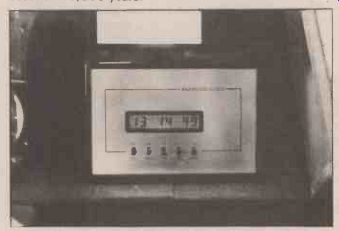
-------- A typical MSF receiver, this one operates on one
of the 'slow codes, as you can see the controls are kept to a minimum.
We wonder how long it will be before a domestic version is on sale.
TIM AND TELETEXT
Both TIM (the Post Office speaking clock) and the BBC (Ceefax) and IBA (Oracle) Teletext services are linked to the Rugby MSF time signal.
TIM is a pre-recorded (in 1963 would you believe) on to a rubber tape (mixed with Iron Oxide particles you fool). The rubber tape or 'tire' is fitted over a spinning brass drum. The 'tape' is split into 79 tracks containing all the well known phrases. Track number one has the
'At the third stroke it will be ...' phrase. Tracks 2 to 12 have the hour phrases, ' ... o'clock'. The next 60 tracks have the minutes, 'one to fifty nine', and the final six tracks have the ten second intervals and the famous 'precisely'. In all there are 12 replay heads scanning the 'tape, they are not actually in physical contact with the tape to avoid wear.
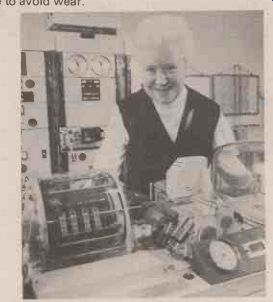
------ Mr and Miss TIM, the lady is Miss Pat Simmons who
gets something like 430 million phone calls a year; we're told she
even phones herself every morning to check the time. Pat retired
in 1976 but her original recording made in 1963 will continue for
many years to come. The recording actually took over two weeks to
record, we're not surprised.
There are four main speaking clocks in the British Isles, one in constant use (plus one for backup and checking) in London and a further two in Liverpool.
The accuracy of TIM is checked against MSF Rugby and any variation is compensated for by 'advance and Retard' circuits that regulate the speed of the spinning drum. TIM is accurate to within 2 mS (milliseconds) in any one second and an average of 6 mS in any 24-hour period, not bad for 2 pence.
TELLY TIME
Both the major Teletext services, Ceefax and Oracle are now linked to MSF via their computers. The Ceefax clock (transmitted on the top of every teletext page) is accurate to within 1 / 50th of a second. The Oracle (also on the top of every page), clock has at the time of writing only "just been connected to MSF so figures are not available but we would suspect its accuracy to be similar to Ceefax.
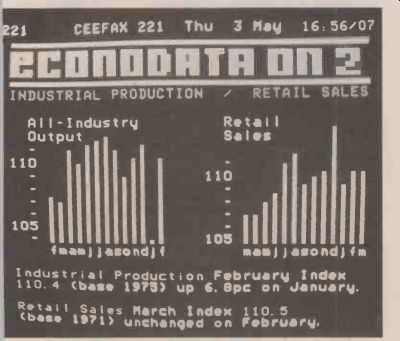
----CEEFAX, the clock can be seen on the 'header' on the left-hand
side. CEEFAX and ORACLE are both linked to the MSF clock at Rugby
so should be accurate to within one-fiftieth of a second.
PERSONAL TIME
All the timepieces discussed so far rely upon a central source of reference, either the Atomic Standard, the mains frequency or even the Sun in the case of a sundial.
When time keeping gets to a portable level, i.e., a wrist watch it becomes necessary to carry around your own reference. At the moment its a little impractical to carry a Cesium beam oscillator on your wrist so our old friend the Quartz crystal oscillator has to suffice. A few years ago, 1960 to be precise (pun intended), the first electronic wristwatch from Bulova actually contained an electronically driven tuning fork. This was mechanically connected via a ratchet wheel to the hands. In its day it was as good if not better than most mechanical chronometers, the manufacturers even gave a written guarantee confirming it to be accurate to within a second per month. Many so-called electronic 'chronographs' of today are hard pressed to better that. Unfortunately, the watch for all its ingenuity still relied on moving parts to operate, and eventually they would wear out.
Back to the present. Today's LCD, LED and now Lithium digital watches all have one thing in common, a quartz oscillator. Up until quite recently they all worked at 32.768 kHZ, this strange figure is actually deliberate because it is easily divided with modern digital ICs to a usable 1 Hz. Lately though, higher frequencies of 2.09 and 4 MHz have begun to gain wider acceptance because a-higher frequency leads ultimately to greater accuracy.
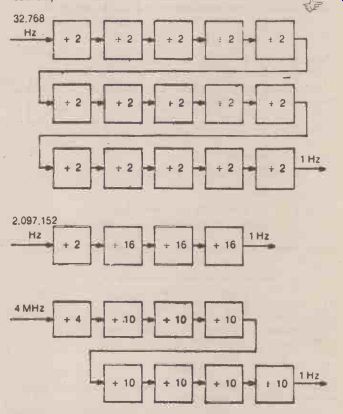
-----Divider chain found most modern digital watches, the three
frequencies are the most common ones in use today. The actual frequency
is governed by a quartz crystal oscillator, this is fed to the chain
inside the IC.
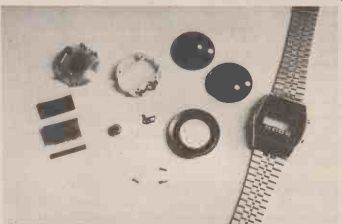
---------Inside one of our own digital alarm watches, we were
surprised to discover the actual bleeper consists of a thin slice
of piezo electric crystal on a metal diaphragm inside the back cover.
The little grill on the front is in fact a dummy, nonetheless it's
loud enough to wake most people. The electronics are sited on the
small PCB top left. The display, beneath the PCB is a liquid crystal
device, it displays a stopwatch, calendar and of course the time
at the expense of only one or two microwatts.
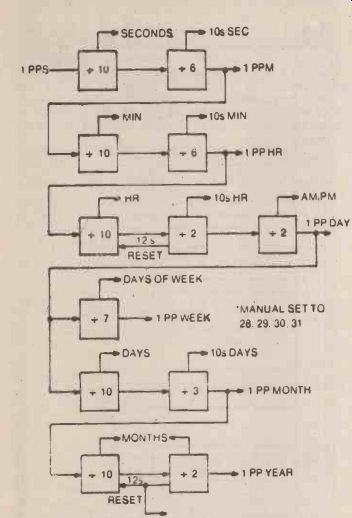
------Divider chain for turning a 1 Hz pulse into hours, minutes,
seconds, days, months, etc, etc.
By using modern CMOS and I2L technology, coupled to an LCD or Lithium display (LEDs tend to be a bit juicy) current consumptions of around 2-5 uA are the order of the day. Indeed a typical LCD watch battery should last in excess of one year. One final point with LCD displays, they are a chemical display and as such have a limited life. Even with modern processes a life expectancy of around five years is to be expected.
Remember that next time you see one for (mult by 1.4 for dollar) £100, check how long its guarantee lasts for. With so many LCD watches around the (mult by 1.4 for dollar) £ 20 mark its just not necessary to spend that much. Wonder how long it'll be before some one comes up with a disposable watch. If the battery life expectancy of these watches is extended much more they'll start to outlive the displays.
THE FUTURE
An obvious development has got to be a domestic MSF receiver, (who knows they may even make a wrist-watch version) already there are commercially available receivers but they tend to be a little too expensive for us mere mortals.
The current flood of cheap mains-locked LED, and Fluorescent bedside, alarm, and mantelpiece clocks will continue to grow, after all who wants to keep winding an old clockwork clock that doesn't tell the time to the second. (Funny thing though, they always did seem to keep going during power cuts.) The way modern society seems to be going, time, (and we mean accurate time) will continue to play a more important role. Clocks and watches will get more and more accurate, cheaper and cheaper and doubtless sprout more and more semi-useless functions. Look out for the Lithium displays, they rely upon a minute piece of radio-active material to illuminate a small screen. This type of display does have a long life and is readable in the dark, something the LCD watch has never been very good at, even with a backlight.
Well, that's about it, we've literally only just scratched at the surface of electronic timekeeping, one thing you can expect though, is its a subject that is going to get even more involved in the next few years, so keep your eyes peeled for an update in the near future.
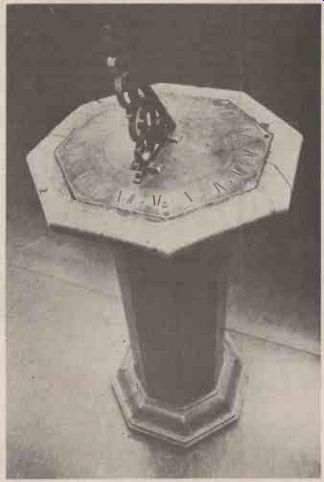
------This is where it all began, man's quest for accurate
timekeeping relied upon logging regular events. The sundial kept
track of the apparent motion of the sun. The more sophisticated
sundials were accurate to within 10 minutes at any time of year,
quite an achievement. Today we measure much shorter events, the
50 Hz of the mains, the oscillations of the quartz crystal, and
if you're really fussy you can count the vibrations of the Cesium
atom and you can't get much more accurate than that!
We would like to thank Hewlett Packard Ltd, the BBC the Post Office and the National Physical Laboratory for their help in preparing this article.
---------
(adapted from: Hobby Electronics magazine, Sept. 1979)
Also see:
Thyristors: The Great Gate Story